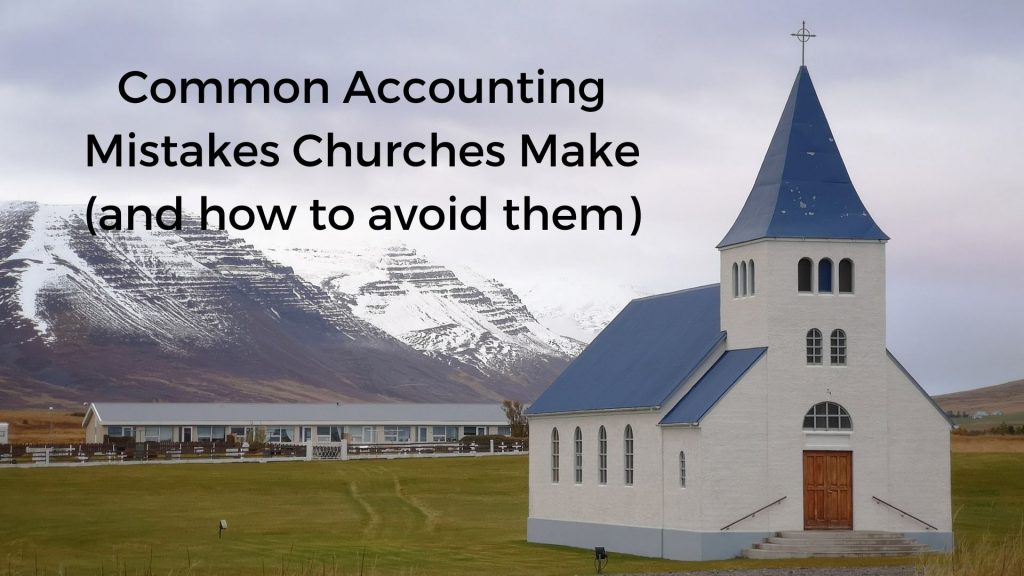Churches and religious nonprofits must maintain highly accurate accounting and bookkeeping records in order to maintain their nonprofit status, budget accurately, and provide reporting to government entities and their parishoners or members. Maintaining accurate accounting can be challenging for churches and there are common mistakes seen in both small and large organizations. To help you avoid these mistakes that can lead to financial or even legal trouble, we’re sharing some solutions and best practices.

Maintaining Designated Funds
Designated funds, also called restricted funds or donor-designated giving, are designed to be specific funds that are only to be used for one specific reason. For example, a church may have a designated fund to pay for a new van and will collect money specifically for that purpose. No matter what happens elsewhere in the budget, any money that a donor designates to that fund or that the church specifically requests donations to must go to that use.
While these designated funds are very popular and have an important use, they can be problematic.
- Because money contributed to the designated fund can only be used for that purpose, the church may be boxed in financially by having thousands of dollars in a fund they can’t touch to pay bills.
- Overall giving to the church offerings are down because more money is designated by the donors to go toward the restricted fund, leaving regular funds short.
- Confusion by church leaders that designated funds can’t be used for other purposes.
- Improper accounting practices means designated funds go to into the general accounts.
The right fund accounting software for nonprofits, such as MIP Fund Accounting® can help you streamline finances and ensure any earmarked money goes into a restricted fund as well as help you maintain that money. Additionally, if you choose to not use a restricted fund and simply set money from your church’s budget into a savings account, the right nonprofit accounting software makes it easy to keep track of that account and effectively budget and plan for future purchases.
Budget Forecasting for Your Church
While most churches do have a monthly budget for expenses, such as personnel, community outreach, and maintenance, budget forecasting is a “quantified expectation” for what you want your church to achieve using donations. While the monthly budget is a guide for where incoming money will go and the financial position of the church, the forecast allows you to show your parishoners where resources are allocated on a long-term map.
Not having a forecast means you don’t have a financial path to meeting your goals. For example, if your church wants to expand community outreach by creating a food bank, your forecast shows how you can back up those goals financially. This builds confidence in the vision and also makes it more likely to turn those goals into a reality.
Using your fund accounting software, such as Financial Edge NXT®, you can map out your budget years into the future, using existing data to set a projection and allowing your church to create a budget forecast that will show your parishoners the goals of the church and what your organization hopes to achieve.
Automate Giving and Donations for Your Church
One of the most effective ways to budget and plan for your church is by setting up recurring giving or automated donation. In a society that relies less and less on cash and checks, passing an offering plate or setting up a donation box is becoming a less secure, consistent way of guaranteeing your church’s revenue.
For example, let’s say a member of your church usually donates $50 on the first Sunday of the month like clockwork, but if are out of town for a few weeks or they get sick and miss a few Sundays, they may not make that tithe. A few missed months is a $150 loss in a year, which isn’t much at all, but if this happens throughout a full congregation, that takes a huge chunk out of your budget.
If those donations are automated, you can not only make the tithing process fast and easy for your members, you can also safeguard against missed payments and set up a more predictable budget.
Setting up automated donations for your members is easy through most banks’ online bill pay. Then, when your church accounting software is linked to your bank, much of your data entry will be complete on donations, saving you time and allowing you to keep up to date records.
Contact Us to Find the Right Accounting Software for Your Church
Most church accounting challenges stem from not having the right support and clarity in your record keeping. With the right nonprofit accounting software, it does the work for you, allowing you to keep accurate records and plan for the future with ease. To learn more about our nonprofit software solutions and choose which is right for you, reach out to a consultant today at (888) 249-6008 to talk with an MIP specialist or fill out the form below to learn more about our nonprofit accounting solutions.
We would love to hear from you! Please fill out this form and we will get back to you shortly.